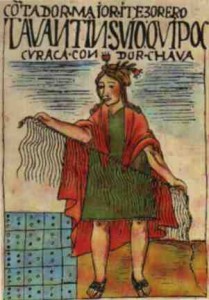Khipu/Quipu: Knotted Strings

Public Domain image.
A knotted, colourful string made out of cotton; while an un-presupposing artefact at first glance, it is in fact one of the most enigmatic encoding systems revealed through archaeological research. The Inca khipu (from the Quechua for ‘knot’) has fascinated scholars since Spanish accounts first relayed details of the depth of information encoded within these outwardly simple seeming strings; from varying agricultural productivity in different provinces, through simple census data, to more complex accounts of the feats of kings. The khipu stands as a compelling case for how archaeology can reveal complex and innovatively different technological solutions to humanity’s continued demand for external storage of knowledge.
Reading
The Khipu database project: http://khipukamayuq.fas.harvard.edu/
Urton, G., 2010. Recording measure(ment)s in the Inka Khipu. In Morley, I. and Renfrew, C. (eds), The Archaeology of Measurement: comprehending Heaven, Earth and Time in Ancient Societies, 54-68. Cambridge University Press: Cambridge

Leave a Reply